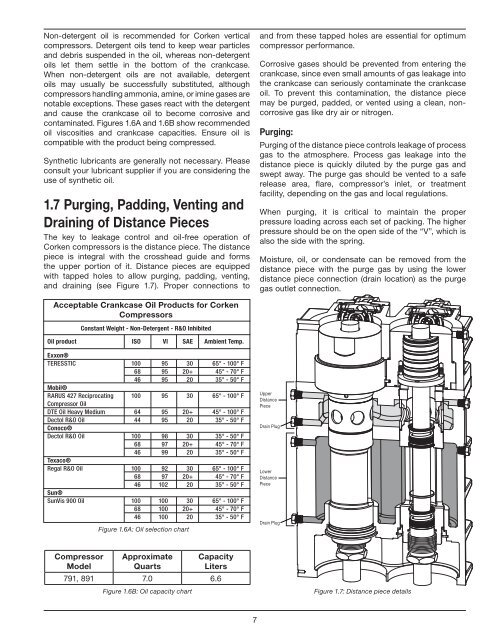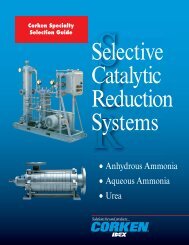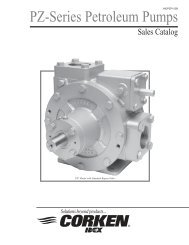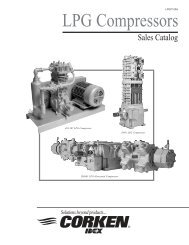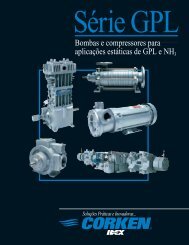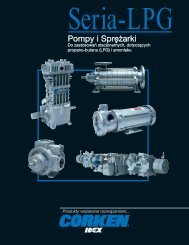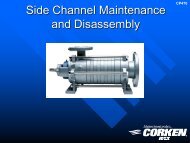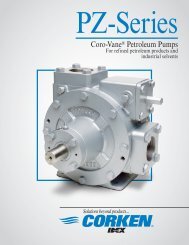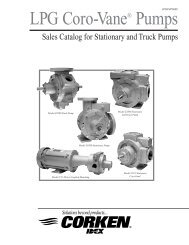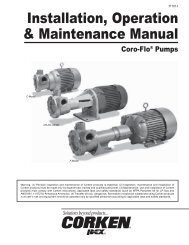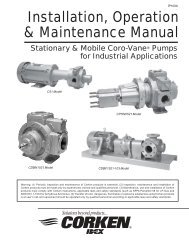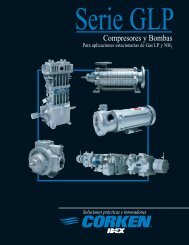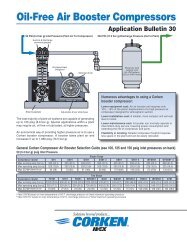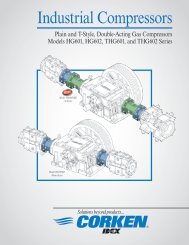Installation, Operation & Maintenance Manual - Corken
Installation, Operation & Maintenance Manual - Corken
Installation, Operation & Maintenance Manual - Corken
You also want an ePaper? Increase the reach of your titles
YUMPU automatically turns print PDFs into web optimized ePapers that Google loves.
Non-detergent oil is recommended for <strong>Corken</strong> vertical<br />
compressors. Detergent oils tend to keep wear particles<br />
and debris suspended in the oil, whereas non-detergent<br />
oils let them settle in the bottom of the crankcase.<br />
When non-detergent oils are not available, detergent<br />
oils may usually be successfully substituted, although<br />
compressors handling ammonia, amine, or imine gases are<br />
notable exceptions. These gases react with the detergent<br />
and cause the crankcase oil to become corrosive and<br />
contaminated. Figures 1.6A and 1.6B show recommended<br />
oil viscosities and crankcase capacities. Ensure oil is<br />
compatible with the product being compressed.<br />
Synthetic lubricants are generally not necessary. Please<br />
consult your lubricant supplier if you are considering the<br />
use of synthetic oil.<br />
1.7 Purging, Padding, Venting and<br />
Draining of Distance Pieces<br />
The key to leakage control and oil-free operation of<br />
<strong>Corken</strong> compressors is the distance piece. The distance<br />
piece is integral with the crosshead guide and forms<br />
the upper portion of it. Distance pieces are equipped<br />
with tapped holes to allow purging, padding, venting,<br />
and draining (see Figure 1.7). Proper connections to<br />
and from these tapped holes are essential for optimum<br />
compressor performance.<br />
Corrosive gases should be prevented from entering the<br />
crankcase, since even small amounts of gas leakage into<br />
the crankcase can seriously contaminate the crankcase<br />
oil. To prevent this contamination, the distance piece<br />
may be purged, padded, or vented using a clean, noncorrosive<br />
gas like dry air or nitrogen.<br />
Purging:<br />
Purging of the distance piece controls leakage of process<br />
gas to the atmosphere. Process gas leakage into the<br />
distance piece is quickly diluted by the purge gas and<br />
swept away. The purge gas should be vented to a safe<br />
release area, flare, compressor’s inlet, or treatment<br />
facility, depending on the gas and local regulations.<br />
When purging, it is critical to maintain the proper<br />
pressure loading across each set of packing. The higher<br />
pressure should be on the open side of the “V”, which is<br />
also the side with the spring.<br />
Moisture, oil, or condensate can be removed from the<br />
distance piece with the purge gas by using the lower<br />
distance piece connection (drain location) as the purge<br />
gas outlet connection.<br />
Acceptable Crankcase Oil Products for <strong>Corken</strong><br />
Compressors<br />
Constant Weight - Non-Detergent - R&O Inhibited<br />
Oil product ISO VI SAE Ambient Temp.<br />
Exxon®<br />
Teresstic 100 95 30 65° - 100° F<br />
68 95 20+ 45° - 70° F<br />
46 95 20 35° - 50° F<br />
Mobil®<br />
RARUS 427 Reciprocating 100 95 30 65° - 100° F<br />
Compressor Oil<br />
DTE Oil Heavy Medium 64 95 20+ 45° - 100° F<br />
Dectol R&O Oil 44 95 20 35° - 50° F<br />
Conoco®<br />
Dectol R&O Oil 100 98 30 35° - 50° F<br />
68 97 20+ 45° - 70° F<br />
46 99 20 35° - 50° F<br />
Texaco®<br />
Regal R&O Oil 100 92 30 65° - 100° F<br />
68 97 20+ 45° - 70° F<br />
46 102 20 35° - 50° F<br />
Sun®<br />
SunVis 900 Oil 100 100 30 65° - 100° F<br />
68 100 20+ 45° - 70° F<br />
46 100 20 35° - 50° F<br />
Figure 1.6A: Oil selection chart<br />
Upper<br />
Distance<br />
Piece<br />
Drain Plug<br />
Lower<br />
Distance<br />
Piece<br />
Drain Plug<br />
Compressor<br />
Model<br />
Approximate<br />
Quarts<br />
Capacity<br />
Liters<br />
791, 891 7.0 6.6<br />
Figure 1.6B: Oil capacity chart<br />
Figure 1.7: Distance piece details<br />
7


